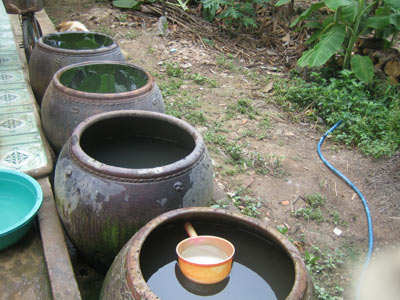Dengue fever increases due to water tanks
In a study in Khanh Hoa, health experts were concerned that the construction of a water supply system could contribute to the spread of dengue fever, after finding 2000 liters of water tanks to produce 92% of the larvae. .
The above warnings were made during the three-year evaluation meeting of the project "Reducing the risk of dengue in the field of rural water supply projects in the Mekong Delta region (2005 - 2010)", held in HCM City on July 31.
The project is implemented in 6 communes in 3 provinces of Long An, Vinh Long, and Ben Tre to reduce the risk of spreading fever in the community.
After 2 years and 4 months of implementation, the mosquito density decreased by an average of 82% compared to the previous time. The index of larval density also decreased by an average of 80%. More importantly, the transmission vector population is particularly reduced in the third year.

The water supply system may be the agent that spread dengue.Artwork: H.Cat
Previously, from September 2001 to September 2007, the project "Supplying rural clean water in the Mekong Delta provinces" funded by AusAID has been implemented in 5 provinces of Long An, Ben Tre, Vinh Long and Bac. Lieu, and Kien Giang. Accordingly, 51 water supply works have been built by pipelines, 21,000 luong reservoirs for households, 118 school sanitation areas and 232 wells for households.
According to MSc. Doctor Luong Chan Quang, expert in dengue prevention, Department of Public Health - Ho Chi Minh City Pasteur Institute, now in Long An most people contain water in large items, and eliminate the habit of using Small crutch. At the same time, people carry out protective measures such as covering, regularly cleaning, dropping mesocyclops .
Aedes aegypti mosquitoes, species that transmit dengue fever, reproduce in man-made water containers: water jars, water tanks, and wells. The World Health Organization (WHO) also acknowledges the construction of a water supply system that contributes to the spread of dengue and water-borne disease-related diseases.
According to the report of the Ministry of Health, in July 2008, there were 27 localities with a total of 7.606 / 8 infected / dead. The cumulative number of cases / deaths in the country from the beginning of the year to date is 22,918 / 24. compared with the same period in 2007, the number of cases decreased by 31%, the number of deaths decreased by 30%.
Dengue fever is showing signs of increasing; hot spots are Bac Lieu, Ca Mau, Soc Trang. In Ho Chi Minh City, hot spots are in suburban districts and suburban districts such as Binh Chanh, Thu Duc, District 8 and District 6.
The concern is the dengue situation in the eastern provinces like Dong Nai, Binh Duong and Binh Phuoc. For many years, dengue fever has rarely appeared in these provinces, so people are not immune. Therefore, prevention is not good, dengue epidemic is difficult to control.
- How to identify children with dengue fever
- How is dengue outbreaks raging?
- What should I do and how to eat and drink when I have dengue fever?
- Hanoi: Dengue epidemic is complicated, the number of cases increases
- Against dengue fever is stalking
- Severe recognition makes more and more people suffer from dengue
- Video: Signs that you have dengue fever
- Singapore will have a rapid detection device for dengue fever
- Dengue fever in the epidemic season in the South
- Dengue alarm is raging in Hanoi
- Successful production of dengue vaccine after 20 years of research
- Can dengue fever be transmitted sexually?
 Green tea cleans teeth better than mouthwash?
Green tea cleans teeth better than mouthwash? Death kiss: This is why you should not let anyone kiss your baby's lips
Death kiss: This is why you should not let anyone kiss your baby's lips What is salmonellosis?
What is salmonellosis? Caution should be exercised when using aloe vera through eating and drinking
Caution should be exercised when using aloe vera through eating and drinking